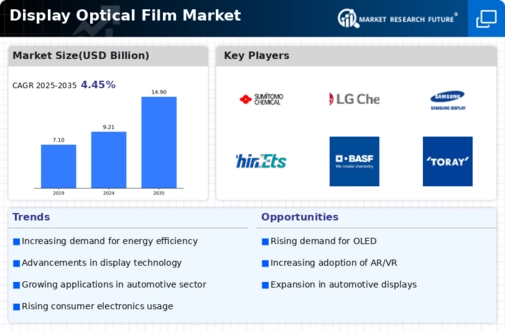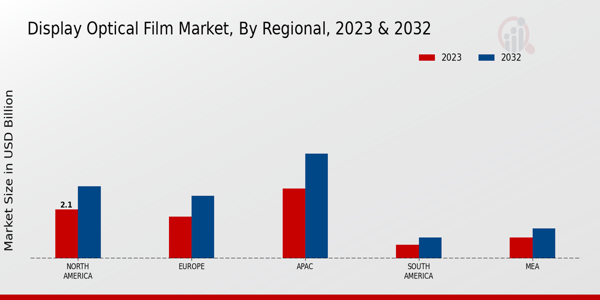Market Trends and Projections
Rising Demand for Consumer Electronics
The Global Display Optical Film Market Industry experiences a notable surge in demand driven by the proliferation of consumer electronics. With the increasing adoption of smartphones, tablets, and laptops, the need for high-quality display solutions becomes paramount. In 2024, the market is projected to reach 9.21 USD Billion, reflecting a growing consumer preference for devices equipped with advanced display technologies. This trend is likely to continue as manufacturers strive to enhance visual experiences, thereby propelling the demand for optical films that improve brightness, contrast, and color accuracy.
Emerging Markets and Increased Urbanization
Emerging markets and increased urbanization are pivotal factors influencing the Global Display Optical Film Market Industry. As urban populations grow, the demand for consumer electronics and advanced display technologies escalates. Countries in Asia-Pacific and Latin America are witnessing rapid urbanization, leading to a surge in the adoption of devices that utilize optical films. This demographic shift is expected to create new opportunities for manufacturers, as they cater to the evolving needs of urban consumers. The market's growth trajectory indicates that these emerging regions will play a crucial role in shaping the future landscape of the optical film industry.
Expansion of Automotive Display Applications
The expansion of automotive display applications is a key driver for the Global Display Optical Film Market Industry. As vehicles become more technologically advanced, the integration of sophisticated display systems is on the rise. Optical films are essential for enhancing the visibility and functionality of displays in cars, contributing to improved driver experience and safety. This trend is particularly evident in the growing popularity of infotainment systems and digital dashboards. The automotive sector's increasing reliance on high-quality displays is likely to bolster demand for optical films, positioning this segment as a significant contributor to market growth in the coming years.
Growing Demand for Energy-Efficient Solutions
The Global Display Optical Film Market Industry is significantly influenced by the rising demand for energy-efficient solutions. As environmental concerns gain prominence, manufacturers are increasingly seeking materials that reduce energy consumption in display devices. Optical films that enhance light utilization and minimize power usage align with sustainability goals, making them attractive to both consumers and manufacturers. This trend is expected to drive market growth, as energy-efficient displays become a standard in consumer electronics. The market's trajectory suggests that by 2035, it could reach 14.9 USD Billion, underscoring the importance of energy-efficient optical films in future developments.
Technological Advancements in Display Technologies
Technological innovations play a crucial role in shaping the Global Display Optical Film Market Industry. The advent of OLED and LCD technologies necessitates the development of specialized optical films that cater to their unique requirements. As manufacturers invest in research and development, the introduction of films that enhance light transmission and reduce glare becomes increasingly prevalent. This focus on innovation is expected to contribute to the market's growth, with projections indicating a compound annual growth rate of 4.46% from 2025 to 2035. Such advancements not only improve display quality but also expand the range of applications across various sectors.












